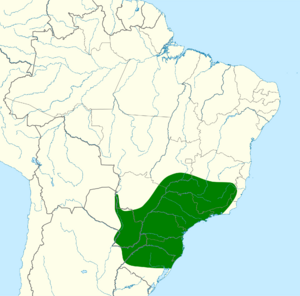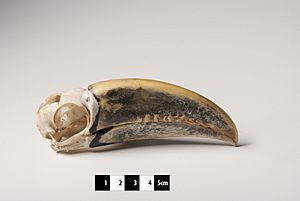Red-breasted toucan facts for kids
Quick facts for kids Red-breasted toucan |
|
|---|---|
 |
|
| In Parque das Aves, Brazil | |
| Conservation status | |
| Scientific classification | |
| Genus: |
Ramphastos
|
| Species: |
dicolorus
|
 |
|
| Synonyms | |
|
|
The red-breasted toucan is also known as the green-billed toucan. Its scientific name is Ramphastos dicolorus. This colorful bird belongs to the toucan family, called Ramphastidae. You can find these toucans living in parts of South America, including Argentina, Brazil, Bolivia, and Paraguay.
Contents
About the Red-Breasted Toucan Family
The red-breasted toucan is closely related to other toucans. It is like a "sister species" to the channel-billed toucan and the Choco toucan. This means they share a common ancestor. The red-breasted toucan is a unique species and does not have any subspecies.
What Does the Red-Breasted Toucan Look Like?
The red-breasted toucan is a medium-sized bird. It is about 42 to 48 centimeters (16.5 to 19 inches) long. It weighs between 265 and 400 grams (9.3 to 14 ounces). This makes it the smallest toucan in its group, the Ramphastos genus.
Both male and female toucans look similar. However, the female's bill is a bit shorter than the male's. Their bill is mostly green or yellow-green. It has a black line at its base. The bill also has red and ivory "teeth" along the edges. You might see some green stripes on the upper part of its bill.
The top of their head, neck, back, and tail are black. But they have bright red feathers under their tail. Their face is yellow, with bare skin around their eyes. This skin can be red, blue, and yellow-green. Their throat and chest are yellow, with a red patch on the lower chest. Their belly and the feathers under their tail are red. The sides of their body are black.
Where Do Red-Breasted Toucans Live?
Red-breasted toucans live in several South American countries. They are found in south-central, east-central, and southeastern Brazil. Their range extends south through eastern Paraguay and Bolivia. You can also find them in northern Argentina.
These toucans mostly live in forests. They prefer subtropical and tropical forests, especially in mountains. They can also be found in scrublands, savannas with trees, and even plantations. They usually live at elevations between 100 and 1500 meters (330 to 4,900 feet). Sometimes, they can be seen as high as 2070 meters (6,800 feet), but this is rare.
How Do Red-Breasted Toucans Behave?
Movement and Migration
In the southern parts of their home range, red-breasted toucans move to lower areas during the winter. After they finish breeding, some toucans might move from natural forests into plantations.
What Do Red-Breasted Toucans Eat?
Red-breasted toucans mostly eat fruits. They enjoy fruits from both native plants and those brought in by people. They also eat green coffee beans and fruit from orchards. Sometimes, they will eat insects and even small birds.
They usually look for food in pairs or small groups. However, more than 20 toucans might gather together at times. They typically forage high up in the forest canopy. But they will also pick up fallen fruit from the ground.
Reproduction and Life Cycle
Red-breasted toucans breed at different times depending on where they live. In the southern part of their range, breeding happens from October to February. In the north, it's from January to June. Each pair of toucans defends its own territory.
Male toucans show affection by preening the female's feathers. They also offer her food as a courtship gift. These birds nest in holes found in trees. These holes can be natural, or they might be old woodpecker nests. Toucans can make the entrance hole or the cavity bigger if needed. The bottom of the nest usually has a layer of seeds that the toucans have spit out.
The nests that have been studied were found from 0.7 to 6.0 meters (2.3 to 20 feet) above the ground. A female toucan usually lays two to four eggs. Both parents take turns sitting on the eggs to keep them warm. Both parents also feed the baby toucans once they hatch. The eggs hatch in about 16 to 19 days. The young toucans are ready to leave the nest about 40 to 50 days after hatching.
Sounds and Calls
The red-breasted toucan is known as one of the "croaker" toucans. Its song is a loud, rough sound that sounds like "WRèh" or "niuh." They also make a long series of noisy honking sounds, like "grrekk." Other calls include low "ek" sounds, "zneep" sounds, and growl-like begging noises. Besides vocal sounds, they also clap their bills together and rattle their tongues inside their bills.
How Are Red-Breasted Toucans Doing?
The IUCN (International Union for Conservation of Nature) first thought the red-breasted toucan was "Near Threatened." But since 2004, they have changed its status to "Least Concern." This means it is not currently at high risk of disappearing.
The red-breasted toucan lives in a very large area. However, we don't know exactly how many there are. Scientists believe their numbers might be slowly decreasing. No major threats have been found for them right now. They are generally thought to be "reasonably common."
These toucans live in several protected areas. But outside these areas, people sometimes hunt them. They can also be seen as a problem if they eat fruit from orchards.
See also
 In Spanish: Tucán bicolor para niños
In Spanish: Tucán bicolor para niños



